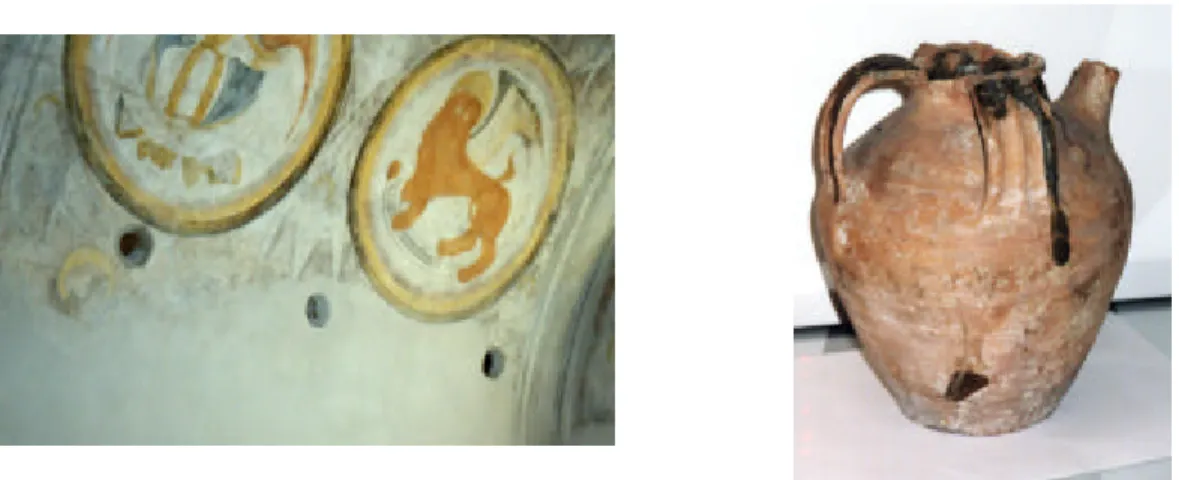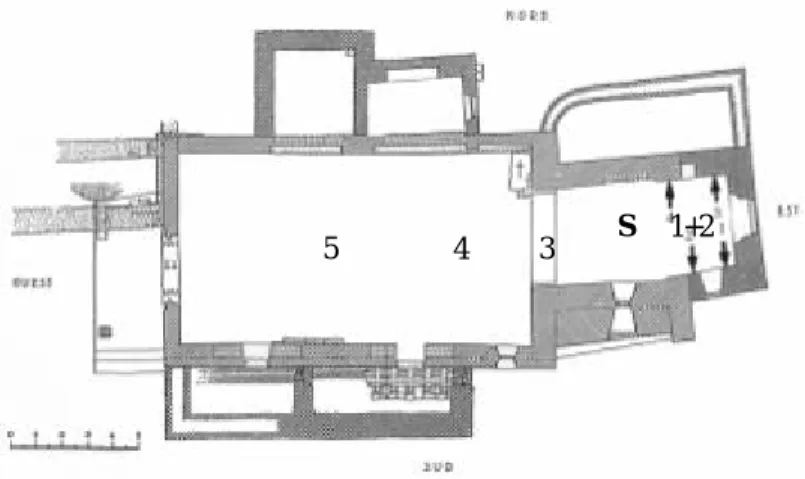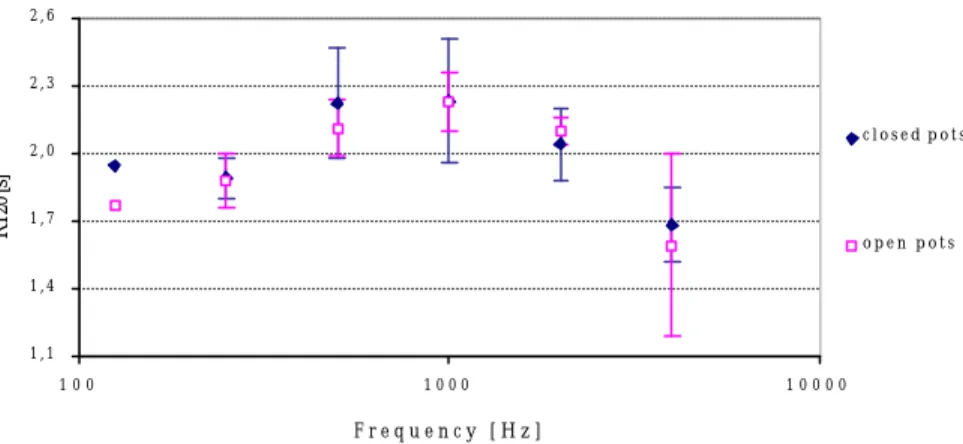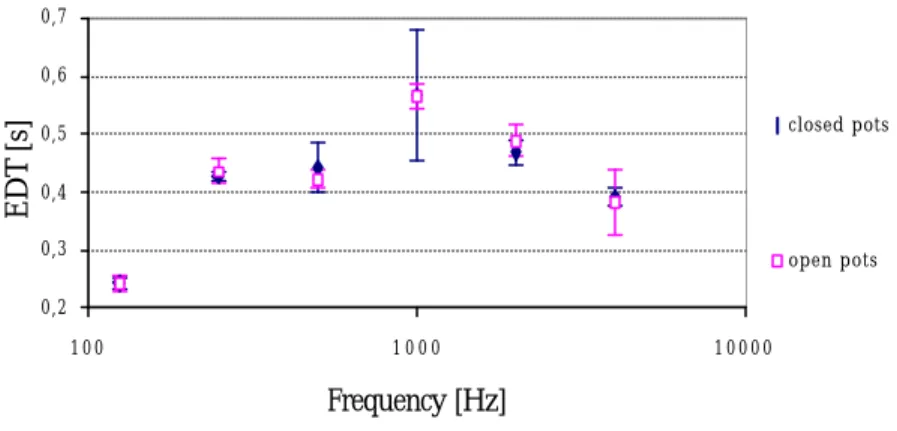Portland, Maine
NOISE-CON 2001
2001 October 29-31EFFICIENCY OF 13TH-CENTURY
ACOUSTIC CERAMIC POTS IN TWO
SWISS CHURCHES
Victor Desarnaulds*, Yves Loerincik*, António P. O. Carvalho**
* École Polyt. Fédérale Lausanne (EPFL), 1015 Lausanne, Switzerland, desarnaulds@monay.ch
** Univ. of Porto, Faculty of Eng., Acoustics Lab., 4200-465 Porto, Portugal, carvalho@fe.up.pt
INTRODUCTION
From the eleventh to the sixteenth century, but especially during the Romanesque and Gothic time, certain churches and mosques [1] were fitted with pots embedded in the walls or on the vaults. The principal function of these "acoustic pots" was to amplify and make resound the voice but their utility was however always controversial [2]. If the pots were really effective, one can wonder why are they not found in a more systematic way in the European churches and why their use was suddenly stopped? If on the contrary they were ineffective, one can ask why the architects were so stubborn to have been placing these pots during mo re than six centuries? We must recognize however as Viollet-le-Duc that "effective or not, it is certain that this mode of sonority was allowed during Middle Age". Let us recall that the use of pots for acoustic purposes comes from antiquity. Several fa mous authors like Aristotle [3] or Vitruvius [4] described the use and the function of the echea. These terracotta or bronze pots were laid out in the ground or under the steps of the ancient theatres to improve the acoustics.
The potteries installed in the churches are generally vases, jugs or pots with or without handles, made out of ceramics with red or gray paste, sometimes glazed, whose main function was undoubtedly utilitarian. The potteries employed are, sometimes even within the same church, of very variable form and size (figures 2 and 8). The pots are in general dispersed in the choir (sometimes at the height of the priest or singers), facing the pulpit or above the platform. Generally they are found in the higher part of the church (in the vaults or at the top of the walls, in particular close to the angles) or around the windows. The acoustic pots are always embedded with the visible open aperture placed on the plan of the wall, sometimes integrated with the surrounding pictorial decoration (figure 1).
Although already described by Thorschmid in 1725 [5], the use of acoustic pots in churches gave only place,
until the middle of the nineteenth century, to marginal publications on behalf of art historians in particular of J. Rahn [6]. It is at the beginning of the twentieth century that many countries, whose Switzerland, exhume, often at the time of restoration, these acoustic pots [7], which were the subject of some scientific research at the second half of that century [8,9].
The acoustic pots are in fact Helmholtz resonators but the geometry of the pots makes sometimes difficult the determination of the typical parameters as a Helmholtz resonator (the length of the neck for example). Preliminary measurements in laboratory [10] showed the weak range of action regarding the sound level amplification near the pots and the low efficiency regarding sound absorption. In situ, the effects on sound level and reverberation time should be then very unlikely. What can be expected is a different distribution of the energy (C50) and a small effect on the EDT possibly involving a modification in the speech intelligibility. From an incident plane wave, the pot radiates a secondary spherical wave with amplification around its fundamental frequency. This effect of diffusion can be useful to attenuate the focusing effects (for instance, from the vaults).
The purpose of this study is to check the in situ effectiveness of these acoustic devices, in particular with regard to speech intelligibility.
METHOD
Acoustic measurements were done in the Swiss churches of Villette and Syens whose acoustic pots were recently the subject of archaeological analyses [11] that detailed their form, composition and positions. Measurements were carried out with a MLSSA system that uses a MLS sequence (Maximum Length Sequence). This method makes it possible to determine various parameters (RT, EDT, STI, C50, etc.) from the room impulse response for each
source/receiver position. To reduce the measuring time, the measurements were carried out in an asynchronous way using two DAT Casio DA-7 recorders, being the analyses carried out in the laboratory. In this manner the interior conditions during measurements (moisture, temperature, etc) remain relatively stable. The measurement principle was to send a pseudo-random MLS signal by the first DAT recorder and a loudspeaker. The response was recorded using the second DAT recorder on the chosen place in the church. The pots were closed using cork stoppers that a string made possible to quickly remove. An average of six measures was carried out in each measuring position. Sound level measurements by 1/3 octave (open and closed pots) were also taken using a RION NA-27 sound level meter at various distances between 0.1 and 0.7 m of a pot. The sent signal is a MLS sequence (broadband) to approach the spectrum of the speech, very different from a sinusoidal signal.
THE VILLETTE CHURCH
Church description. The Villette church (volume about 830 m3) has a choir dating from the 13th-14th centuries now with four acoustic pots. In the northern side and at 3.8 m height there are two red terracotta pots with a brown -yellow varnish inside. In the south side, the two other pots, of the same material and also located at 3.8 m height, are in the original masonry integrated in a mural of the fifteenth century (figures 1 and 2). Measurements were taken at 1.5 m height (except position 1 that was at 4 m height, at the pots level, see figure 4).
Figure 1 and 2: Acoustic pots openings at Villette church and one of its pots (found in 1927 and now in a Museum).
Sound level measurements. In laboratory, an increase in the sound intensity was highlighted locally for the
frequency of resonance of the pot. In the church, no significant difference could be found at any distance (figure 3). That is explained by the selectivity in frequency of the pots (only the resonance frequencies of the pots are amplified) and the broadband measuring device used (emission of MLS a signal and analyses by 1/3 octave). Only an analysis in fine band, in particular around the fundamental frequency of the pot, would make it possible to highlight the phenomenon of localized amplification.
Figure 3: Villette church - Sound level differences from open to closed pots at a distance of 10 cm.
4 0 5 0 6 0 7 0 8 0 1 0 1 0 0 1 0 0 0 1 0 0 0 0 Frequency [Hz] Leq [dB] o p e n p o t s c l o s e d p o t s
1+2 3
4
5 S
C50. The C50 values for the 250 and 500 Hz frequency bands are lower when the pots are open especially in position
1 (figure 5). In the other positions in the choir a less marked decrease is observed. In the nave, on the contrary, no difference can be found. The decrease of the C50 values can be explained by the role of secondary sources and of diffusers that the pots play. Indeed, the introduction of secondary sources would tend to generate a delay in the energy that arrives at the microphone and thus to decrease the C50 value. However, the reduction in this parameter does not go in the direction of an improvement of the speech intelligibility. Therefore, one can expect a weak reduction in the STI values especially in the choir.
Figure 4: Villette church - S (sound source), 5 receiver positions and the 4 pots in the choir.
Figure 5: Villette church - C50 values, open and closed pots (position 1).
Speech Transmission Index (STI). The STI results are presented in table 1. Generally, a very weak decrease of the
STI is noticed when the pots are open. This reduction is not more significant in the choir than in the nave and the variation is included in the uncertainty domain.
Table 1: Villette church - STI comparison between open and closed pots.
Position STI closed pots ± STI open pots ± ∆ STI (=open-closed)
1 0.56 0.03 0.54 0.01 -0.02 2 0.54 0.02 0.53 0.06 -0.01 3 0.46 0.01 0.45 0.02 -0.01 4 0.37 0.03 0.36 0.02 -0.01 5 0.35 0.00 0.32 0.04 -0.03 mean -0.02 standard deviation 0.01 - 3 - 2 - 1 0 1 2 3 4 1 0 0 1 0 0 0 1 0 0 0 0 F r e q u e n c y [ H z ] C50 (dB) c l o s e d p o t s o p e n p o t s
Reverberation Time. The measurements show little difference between the two configurations. The reduction in the
EDT values when the pots are open is hardly observable in position 2 in the 500 and 1000 Hz frequency bands and is at the limit of audibility (figure 6). Almost no difference is observed with the other positions. The number of pots is probably insufficient so that the effect of coupled rooms could be visible. With regard to reverberation time (RT20) no effect could be found. The effect of temporal smoothing, observed by Floriot [9] was studied but also could not be detected. The differences between the open and closed pots configurations are thus very weak in this church.
Figure 6: Villette church - EDT values, open and closed pots (position 2).
Figure 7: Villette church - RT20 values, open and closed pots (position 1).
THE SYENS CHURCH
Church Description. The church of Syens (volume about 990 m3) has a nave of 1787 and a choir dating from the 13th century, arched in tuff, in which, at the time of the 1897 restoration, five terracotta pots were discovered. Now, only four remain, three utilitarian ceramic pots in the north side (height from 14.2 to 17.6 cm, opening from 8.6 to 10.2 cm) and a jug in the south side (figure 8).
Figure 8: Three pots at Syens church.
1 , 1 1 , 4 1 , 7 2 , 0 2 , 3 2 , 6 1 0 0 1 0 0 0 1 0 0 0 0 F r e q u e n c y [ H z ] RT20 [s] c l o s e d p o t s o p e n p o t s 1 , 0 1 , 4 1 , 8 2 , 2 2 , 6 1 0 0 1 0 0 0 1 0 0 0 0 F r e q u e n c y [ H z ] EDT [s] c l o s e d p o t s o p e n p o t s
Measure MLSSA. Measurements were taken at five different places in the church: 1 - In the middle of the choir at
pots' level (≈ 4 m); 2 - In the middle of the choir on the ground; 3 - Between the choir and the nave; 4 - In the nave, on the level of the first pew; 5 - In the nave, on the level of the fifth pew.
C50. Whereas in the choir the effect of the opening of the pots on this parameter is non-existent (figure 9), a very
weak increase is noted with the measurements at the nave mainly at the 250 Hz frequency band (figure 10). It is interesting to notice that the decrease of the C50 values observed in the Church of the Villette is not reproduced in this church.
Figure 9: Syens church - C50 values, open and closed pots (position 1).
Figure 10: Syens church - C50 values, open and closed pots (position 4).
STI and Reverberation Time. The STI results presented in Table 2 are an average to six measures and they do not
undergo practically any change when the pots are closed. No significant effect on the EDT or on the RT20 values is observed (figure 11).
Table 2: Syens church - STI comparison between open and closed pots.
Position STI closed pots ± STI open pots ± ∆STI (=open-closed)
1 0.61 0.03 0.61 0.01 0 2 0.65 0.02 0.64 0.06 -0.01 3 0.54 0.01 0.54 0.02 0 4 0.43 0.03 0.41 0.02 -0.02 5 0.44 0.00 0.42 0.04 -0.02 mean -0.01 standard deviation 0.01 - 8 - 6 - 4 - 2 0 2 4 1 0 0 1 0 0 0 1 0 0 0 0 Frequency [Hz] C50 (dB) closed pots open pots 1 3 5 7 9 11 100 1000 10000 Frequency [Hz] C50 (dB) closed pots open pots
Figure 11: Syens church - EDT values, open and closed pots (in the middle the choir at pots' level).
CONCLUSION
In the two churches studied, the effect of the pots is almost unobservable. Only a weak decrease for the C50 and STI values (localized in frequency and space) is observable in the Villette church with the opening of the pots. In Syens church, very weak variations could be measured between the open and closed pots configurations. The weak variations that could be observed on the measured parameters make very unlikely an audible improvement of the acoustics of these churches by the insertion of the pots.
It is necessary to be careful and not to claim for inefficiency too quickly for the acoustic pots. The efficiency of theses devices depends on the number of pots, their placement, as well as the characteristics of the buildin g itself. The two studied churches in this preliminary analysis are small and have a small number of pots. Their volume is about 910 m3 and they have each only four pots, which gives an average of one mud for about 230 m3. The study of
Floriot showed that on average a church has 25 pots [8]. The church of Grandson for example, has 27 pots for a
volume of 3200 m3, giving an average of one pot for 120 m3. The churches of Villette and Syens now have naves that were built later than their choirs and perhaps contained, at the time, other potteries.
These first results do not allow affirming or discarding, in general, the utility of the pots. Based on laboratory research [10] it is extremely possible that the use of pots could improve the acoustics of certain churches. Additional measurements must be undertaken in other churches (larger, having more pots and located in vaults including focusing effects) to check the range and validity of the above tested hypotheses.
Correctly dimensioned Helmholtz resonators are still largely used to adjust the acoustics of some buildings, in particular in small size studios. In addition, it is interesting to note that acoustic pots are sometimes again used in certain recent constructions of churches [12].
REFERENCES
1. M. Kayili, Use of cavity resonators in Anatolia since Vitruvius, Proceedings 7th Int. Congress on Sound and Vibration, Garmisch-Partenkirchen pp. 1621-8 (2000)
2. V. Desarnaulds et al., Vases acoustiques dans les églises du Moyen Age. Zeitschrift des Schweirerischen Burgenvereins. Moyen Age (à paraître 11/2001)
3. Aristote and P. Louis (trad.), Problèmes (Vol. 2, Les Belles Lettres, 1993)
4. Vitruvius, Chap. V: Des vases du théâtre. in Les dix livres d'architecture (Les Libraires Associés, Paris, 1965 réédition, traduction de Perrault)
5. Thorschmid, Antiquitates plocenses (Leipzip, 1725)
6 J. R. Rahn, Von dem chor der Oetenbacher Kirche. Anzeiger für schweizerische Altertumskunde Vol 1, pp. 26-31 (1869) 7. H. Pfeifer, Schallgefässe in mittelalterlichen Kirchen. Die Denkmalpflege (Vol. 6, pp. 88-90 and 128-130, 1904)
8. J. M. Fontaine, Etude des vases acoustiques disposés dans les églises du XI - XVIIIème siècles (Thèse in CNAM, Paris, 1979) 9. R. Floriot, Contribution à l'étude des vases acoustiques du moyen âge (Thèse in Faculté des sciences Université d'Aix -Marseille,
Marseille, 1964)
10. Y. Loerincik, Etude sur les vases acoustiques (Diplôme in Département de Physique EPFL, Lausanne, 2000)
11. W. Stöckli and F. Wadsack, Vase acoustiques dans le canton de Vaud (Atelier d'Architecture Médiévale SA, Moudon 1999) 12. T. Pretlove, Helmholtz resonators for the new russian orthodox church in London. Acoustics Bulletin, Feb., pp. 11-15 (1998)
0,2 0,3 0,4 0,5 0,6 0,7 1 0 0 1 0 0 0 1 0 0 0 0 Frequency [Hz] EDT [s] closed pots open pots




